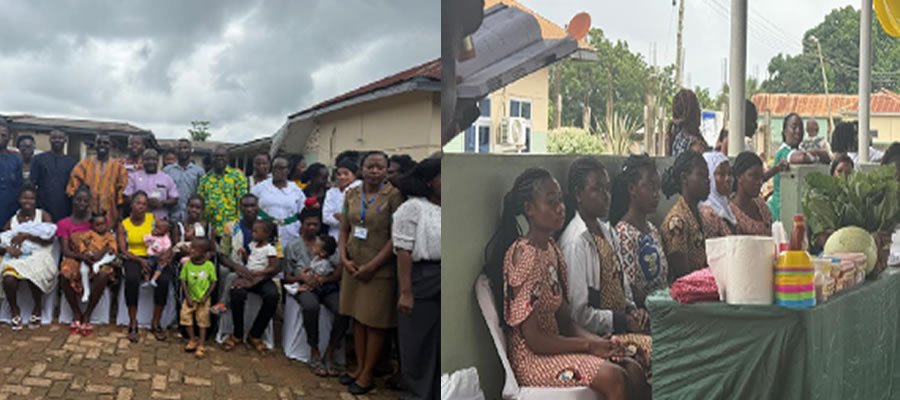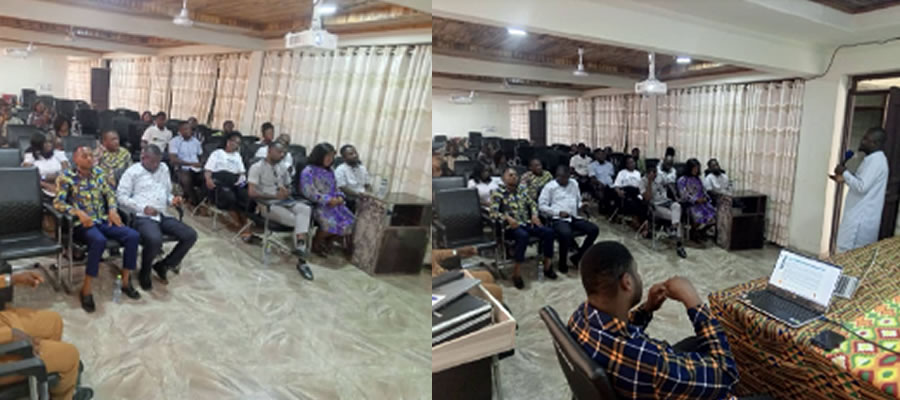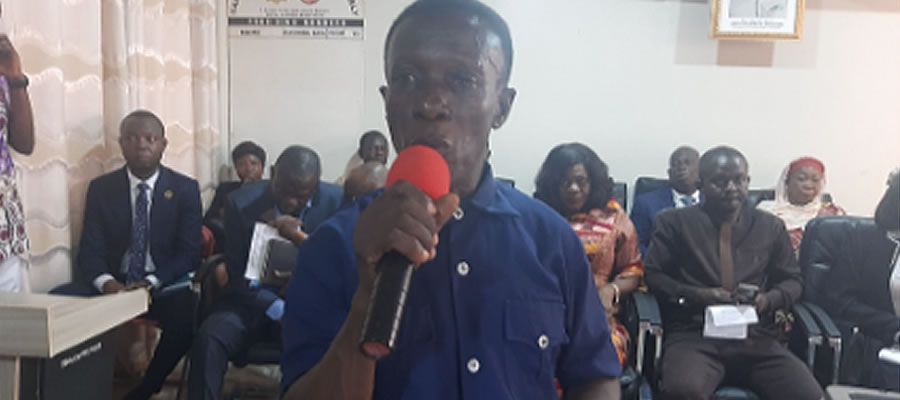

Basic Population Statistics
The recorded population censuses of 1960, 1970 and 1984 of Tano District were 44692, 57662 and 92553 respectively. The population of Tano Municipal from 2000 Census is 123,404, accounting for 6.8 per cent of the Region’s total population. For the immediate preceding census, population increase was 33.3 per cent (1984 – 2000) and represents and inter-censal growth rate of 1.8 per cent which is lower, compared to both the Region’s 2.5 per cent and the National 2.7 per cent.
The increase in population during this period may be due to improved road network which paves way for commercial activities especially the District Capital, Bechem. Also the thriving tomato farming activities at Techimantia and Derma areas and other food crops attracted farmers to the District especially due to a decline in the cocoa industry in the 1970s, farmers were turning to the production of food crops. Improved health delivery system is also a contributory factor to the increase in population.
Tano South Municipal which is carved from Tano Municipal recently has an estimated population of approximately 61,693 in 2006.
Population By Localities
In line with national standards, rural/urban classification of localities is population based on a population size of 5000 or more being urban and less than 5000 being rural. With this definition, only three (3) localities out of the lot are urban in the District. This shows predominance of rural localities in the District.
The urban localities are Bechem (12,591), Techimantia (12,261), and Derma (7,236). Some other relatively large settlements in the District are Dwomo (3,108), New Brosankro (2,019), Breme (1,579), Mansin (1,422) and Ankaase (1,342).
With respect to population distribution in the District, the high density areas are at Bechem, and Techimantia. This is due to the fact that people would want to enjoy higher and better social services and facilities associated with these areas. Other concentrations of population are Dwomo and Derma which are mainly due to the major farming activities taking place in these areas, apart from the provision of essential services.
Farming activities and accessibility also account for the relative population concentrations at Techimantia, Derma and Dwomo. The remaining population are nearly evenly distributed over the district.
Population Distribution by Economic Activity
- About 64% of the labour force is engaged in Agriculture depicting the fact that the major economic activity is predominantly farming. This is followed by commerce (16%), service (14%) and industry (6%) in that order.
- The proportion of labour force in agriculture has been declining over the years with increasing prominence of commerce and services.
- Commercial activities in the District have increased with the establishment of major market centres at Bechem, Techimantia, and Derma. Other factors such as improved road network, communication and financial institutions have also boosted commerce in the District.
- The resource base of the district has facilitated the establishment of small scale industries like table sawmills (Bechem), wood carving (Techimantia and New Brosankro), weaving (Derma) and palm oil extraction (Mansin).
Population Density
The population density for the district has been increasing over the years. The 1960 population density of 29.8 persons per square kilometre increased to 38.4 persons per square kilometre in 1970, 61.7 persons per square kilometre in 1984, and 82.2 persons per square kilometres in 2000. Compared to the regional population density figures of 15 persons per square kilometre in 1960, 19 persons per square kilometre in 1970, 30 persons per square kilometre in 1984 and 45.9 persons per square kilometre in 2000.
The district figures have been quite high
The population density of the district is still high when compared to the national figures of 28 persons per square kilometre in 1960, 36 persons per square kilometre in 1970, 51 persons per square kilometre in 1984 and 79.3 persons per square kilometre in 2000.
Rural Urban Split
In 1960, 37.3% of the population lived in the urban centres. This increased to 46.9% in 1970 but reduced to 41.2% in 1984.
The 2000 Population and Housing Census depicts a rural-urban split of 56.8:43.2 for the District as compared 56.2:43.8 for the nation. However, with about 57% of the settlements in the district being rural, the situation poses a problem for the distribution of higher order services and functions in the district. Services must have the required threshold population before they are provided. The implication therefore is that theoretically many of the settlements may not qualify for higher order services.
Scalogramme
The Scalogramme gives a good practical impression about the functions that settlement performs in a particular locality. It looks at the spatial distribution of functions of all settlements in the District by their frequency of absence or presence. Based on the number and type of services and facilities available, the centrality indices of the District are analyzed which eventually leads to the ranking of settlements.
In constructing the scalogramme, a total of 31 functions were considered on presence or absence in the District. It should be noted that, the number and types of functions included are generally services and facilities present in the District. The settlements in the District were ranked according to population order of magnitude beginning from 12,591. However, this magnitude changes when the functions that exist in a particular settlement are taken into account.
The hierarchy that finally comes out is based on the centrality index, which measures that relative importance of facilities and services present in the settlement. Thus functions are assigned a weight which is inversely proportional to the frequency with which they occur. Therefore, the centrality index for a settlement is the sum of weights of the functions found there.
The higher the index, the greater its functional complexity. By ranking, Bechem emerged the first and more so it is the highly populated settlement in the District followed by Techimantia as depicted in Table 1 below.
Hierarchy of Settlements
- First order settlement - 70+
- Second order settlement - 55 – 69
- Third order settlement - 54 – 40
- Fourth order settlement - 25 – 39
- Fifth order settlement - 24 – below
From the scalogramme, Bechem is the first order settlement with total weighted centrality index of 76.1%. Techimantia and Derma are the third order settlement with total weighted centrality index of 52.2 and 41.8 respectively. Only New Brosankro merits fourth order settlement, the rest of settlements are in the fifth order settlement.
Bechem controls greater proportion of functions in the District. Thus these are centralization of development in Bechem, the District capital and that the facilities in the District are not equitably distributed.
The effect is that it will encourage rural urban drift and there will also be pressure on the existing facilities in Bechem and third order settlements (Techimantia and Derma). Techimantia and Derma must be given facelift and develop to merit second order settlement.
It is sad to note that over 80% of the settlements in the District are in the fifth order settlement. This does not eager well for the District. Therefore efforts should be made to improve and increase facilities in the fifth order settlement.
Age – Sex Distribution
The sex ratio of the Municipality was estimated as 100:99.6 (that is, 1000 males to 996 females) in 1970. The potential labour force (15-64 years) was 46.3% of the population depicting an age dependency ratio of 1:1.2 and economic dependency ratio of 1:1.5 implying that fewer people were working and that every worker had more than one mouth to feed.
In 1984, the sex ratio remained 100:99.6 and the potential labour force was 47.8% depicting an age dependency ratio of 1:1.1. The economic dependency ratio of 1:1.6 was still higher. In 2000 Population and Housing Census, the sex ratio (males to 100 females is 99.5 which is slightly lower than the region’s 100.8.
This indicates that there are far more males than females. This may be accounted for by the presence of migrant farmers. The tables below show the populations of 1970, 1984, 2000 and the current available facilities in 12 largest localities in the District.
Annual Average Household Income Pattern
In order to prepare and present a reliable GPRS II. The Tano South Municpal Assembly undertook a survey on households in some selected urban and rural areas. Below is a highlight on some urban and rural communities annual incomes.
The two major urban and rural communities annual incomes are a reflection of general low incomes in the District. These may be due to the following:
- High unemployment
- Unskilled labour
- Lack of ready market
- Low productivity
- Lack of credit facilities among others.
However, we believe the following measures when considered would improve / raise incomes of our people:
- Job creation
- Organization of training
- Ready market
- Introduction of modern technologies
- Improve technologies of farming
Occupational Distribution
About 64 percent of the labour force is engaged in Agriculture depicting it as the major economic activity. This is followed by commerce (16 percent) service (14 percent) and industry (6 percent) in that order.
Commercial activities in the District have increased with the establishment of major market centres at Bechem, Techimantia, and Derma. They all have both daily and weekly market days. Below is a table depicting their weekly market days:
Other factors such as improved road network, communication and financial institutions have also boosted commercial activities in the District.
Environmental Situation
The District covers a total land area of 1500sqkm with forest area of 322.52sqkm. The District can boast of two forest reserves, namely Bosomkese and Apaape reserves.
Encroachment on the reserve is minimal mainly due to the tight surveillance and the environmental awareness created in the rural people for the control of illegal activities in the forest. The rural people also participate in the establishment of tree plantations.
Bushfires have been a problem and continue to be a problem in the District. This is due to the fact that most farmers use crude farming methods such as slash and burn to clear their farm lands. Also there is rampant group hunting that result in bushfire.
In order to address this situation, the Assembly contributed ¢25m towards District wide Re-Afforestation Project. Also, the Assembly has passed bye-laws to control bushfires.
The Built Environment
Generally, towns in the District are not well Planned and therefore, do not have good internal road network. However, Bechem, the District capital, Techimantia, Derma, New Brosankro and few others have got their layouts prepared based on grid pattern with some good internal access roads.
The commonest building type is the compound house. It accounts for about 90 percent of the total housing units. The majority of the houses are built of Sandcrete and Landcrete which between them constitute 72 percent of the houses in the District. In the urban localities, 90% of the roofing material is made up of iron sheets, while 10% is tiles. The rural locality is having 75% of its roofing material from bamboo and thatch while 25% is iron sheets.
There is also dominance of single storey buildings in the District.
There is the problem of erosion due to the sloping nature of the terrain and poor drainage.
Source: Field Survey – TSDA 2005
Sites Of Historic, Scientific And Aesthetic Importance
- The Bosomkese Forest reserve is the most important, aesthetic and scientific natural resource in the District. In this reserve, one can find different tree species such as ‘Odum’, Mahogany, Ceiba, Cassia and ‘Akasaa’. This reserve is of scientific importance due to the conservation of biodiversity. Some of the trees serve as medicinal plants.
- Moreover, some of the species could be used for carving and other wood works. The forest reserve also serve as habitat for several species of wildlife and game and as water shed for the rivers and streams in the District and beyond.
- There are also traditional shrines in the District. For instance, Taa Dwomo at Dwomo, Daa at Derma and Ahwintakum at Bechem.
The above mentioned shrines serve as centres for cultural and religious studies for both Ghanaians and foreigners alike.
There is also tourist attraction site like Ceiba tree (Onyinakyere) at Dwomo which was said to have been commanded by Komfo Anokye to move from the centre of the road to its present place. It is now being worshiped by the people of Dwomo.
Infrastructure And Service Levels
The District is privileged for its capital to be located on the main Kumasi –Sunyani highway. The District is accessible in terms of feeder roads. One can also make mention of Bechem – Offinso road through Techimantia.
There is a telephone exchange at Bechem the District Capital with private communication centres located in some communities as is depicted on Table 6. The District also enjoys the services of Ghana Telecom One-Touch network, Areeba, Tigo and Kasapa. Plans are also far advanced by some private communication operators to install Internet facilities in the District.
Some hotel/guest house services available in the District include London Guest House, Atobra, Frankies, Grace Guest House, Osei Amadie all in Bechem and others such as in Techimantia and Derma.
There is a Police District Headquarters in the District, Bechem. There are also 4 police stations with 52 personnel. There is one District Court located at Bechem which provides judiciary services in the District. About 60% of the communities in the District enjoy electricity, while the District can boast of 11 filling stations with 4 at Bechem.
Date Created : 11/21/2017 1:13:43 AM












 facebook
facebook
 twitter
twitter
 Youtube
Youtube
 +233 593 831 280
+233 593 831 280 0800 430 430
0800 430 430 GPS: GE-231-4383
GPS: GE-231-4383 info@ghanadistricts.com
info@ghanadistricts.com Box GP1044, Accra, Ghana
Box GP1044, Accra, Ghana